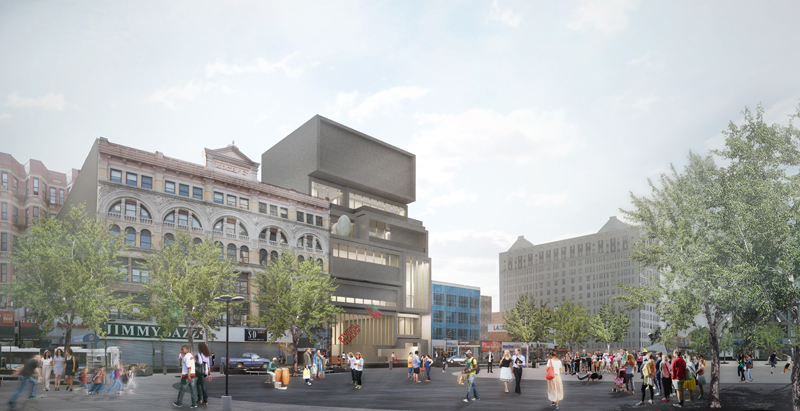For decades, The Studio Museum in Harlem has nurtured up-and-coming artists of African descent and brought them to prominence. Museum director and chief curator Thelma Golden told The New York Times that the museum has “outgrown the space” it currently occupies.
“Our program and our audience require us to answer those demands,” she adds. Hence, the museum has commissioned British-Tanzanian architect David Adjaye to design its new home, slated to begin construction in 2017 for a 2019 completion.
The museum intends to file plans for the building’s conceptual design with the Public Design Commission of the City of New York on July 14.
A press release from The Studio Museum describes Adjaye’s design as “the first home designed expressly for [the museum’s] program.” The public-private initiative, supported by the city of New York, will build the museum, a five-story, 71,000-sf building, on Manhattan’s West 125th Street.
The new scheme takes cues from the brownstones, churches, and bustling sidewalk of Harlem. A public lobby not only will bring grandeur that the museum’s current building can’t offer, but it will also act as a “living room” for the Harlem community and its visitors, thanks to a light-filled core that soars four stories.
Adjaye was selected out of several other architects because of “his sensitivity to artists as well as to the neighborhood,” Golden told the New York Times.
“For generations, artists living and working in Harlem have had an enormous impact on the character and sensibilities of this country. And for the last 50 years The Studio Museum in Harlem has been a pillar for this community, studying, promoting, supporting, and contributing to the cultural fabric of this extraordinary neighborhood and amplifying voices of artists of African descent for an international audience,” New York City Mayor Bill de Blasio said in a statement. “The City’s investment in the future of this organization signals our commitment to helping the Studio Museum grow, engaging a wide audience and maintaining New York’s position at the center of American spirit and identity."
Related Stories
| Sep 12, 2011
Living Buildings: Are AEC Firms up to the Challenge?
Modular Architecture > You’ve done a LEED Gold or two, maybe even a LEED Platinum. But are you and your firm ready to take on the Living Building Challenge? Think twice before you say yes.
| Apr 13, 2011
Expanded Museum of the Moving Image provides a treat for the eyes
The expansion and renovation of the Museum of the Moving Image in the Astoria section of Queens, N.Y., involved a complete redesign of its first floor and the construction of a three-story 47,000-sf addition.
| Apr 12, 2011
Entrance pavilion adds subtle style to Natural History Museum of Los Angeles
A $13 million gift from the Otis Booth Foundation is funding a new entrance pavilion at the Natural History Museum of Los Angeles County. CO Architects, Los Angeles, is designing the frameless structure with an energy-efficient curtain wall, vertical suspension rods, and horizontal knife plates to make it as transparent as possible.
| Jan 21, 2011
Sustainable history center exhibits Fort Ticonderoga’s storied past
Fort Ticonderoga, in Ticonderoga, N.Y., along Lake Champlain, dates to 1755 and was the site of battles in the French and Indian War and the American Revolution. The new $20.8 million, 15,000-sf Deborah Clarke Mars Education Center pays homage to the French magasin du Roi (the King’s warehouse) at the fort.
| Jan 19, 2011
Industrial history museum gets new home in steel plant
The National Museum of Industrial History recently renovated the exterior of a 1913 steel plant in Bethlehem, Pa., to house its new 40,000-sf exhibition space. The museum chose VOA Associates, which is headquartered in Chicago, to complete the design for the exhibit’s interior. The exhibit, which has views of five historic blast furnaces, will feature artifacts from the Smithsonian Institution to illustrate early industrial America.
| Jan 19, 2011
Museum design integrates Greek history and architecture
Construction is under way in Chicago on the National Hellenic Museum, the nation’s first museum devoted to Greek history and culture. RTKL designed the 40,000-sf limestone and glass building to include such historic references as the covered walkway of classical architecture and the natural wood accents of Byzantine monasteries. The museum will include a research library and oral history center, plus a 3,600-sf rooftop terrace featuring three gardens. The project seeks LEED Silver.
| Nov 23, 2010
The George W. Bush Presidential Center, which will house the former president’s library
The George W. Bush Presidential Center, which will house the former president’s library and museum, plus the Bush Institute, is aiming for LEED Platinum. The 226,565-sf center, located at Southern Methodist University, in Dallas, was designed by architect Robert A.M. Stern and landscape architect Michael Van Valkenburgh.
| Nov 2, 2010
Cypress Siding Helps Nature Center Look its Part
The Trinity River Audubon Center, which sits within a 6,000-acre forest just outside Dallas, utilizes sustainable materials that help the $12.5 million nature center fit its wooded setting and put it on a path to earning LEED Gold.
| Oct 13, 2010
Tower commemorates Lewis & Clark’s historic expedition
The $4.8 million Lewis and Clark Confluence Tower in Hartford, Ill., commemorates explorers Meriwether Lewis and William Clark at the point where their trek to the Pacific Ocean began—the confluence of the Mississippi and Missouri Rivers.
| Oct 12, 2010
Gartner Auditorium, Cleveland Museum of Art
27th Annual Reconstruction Awards—Silver Award. Gartner Auditorium was originally designed by Marcel Breuer and completed, in 1971, as part of his Education Wing at the Cleveland Museum of Art. Despite that lofty provenance, the Gartner was never a perfect music venue.
















